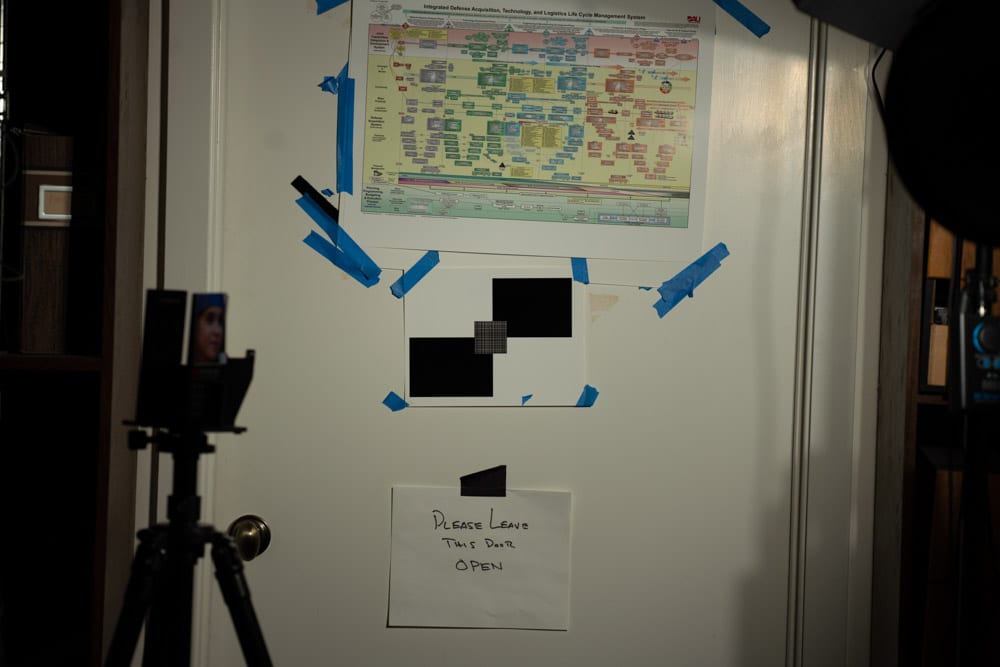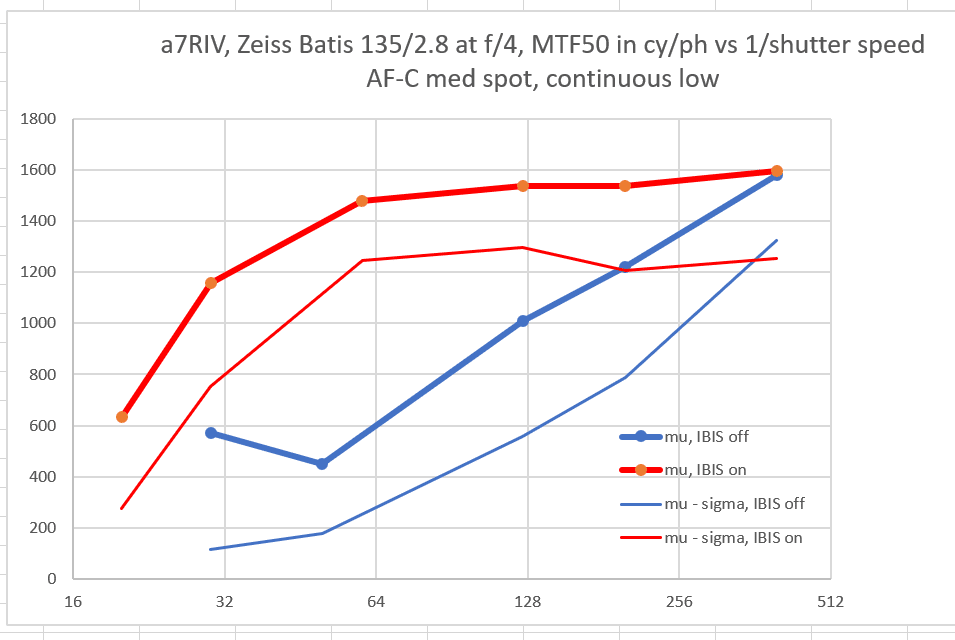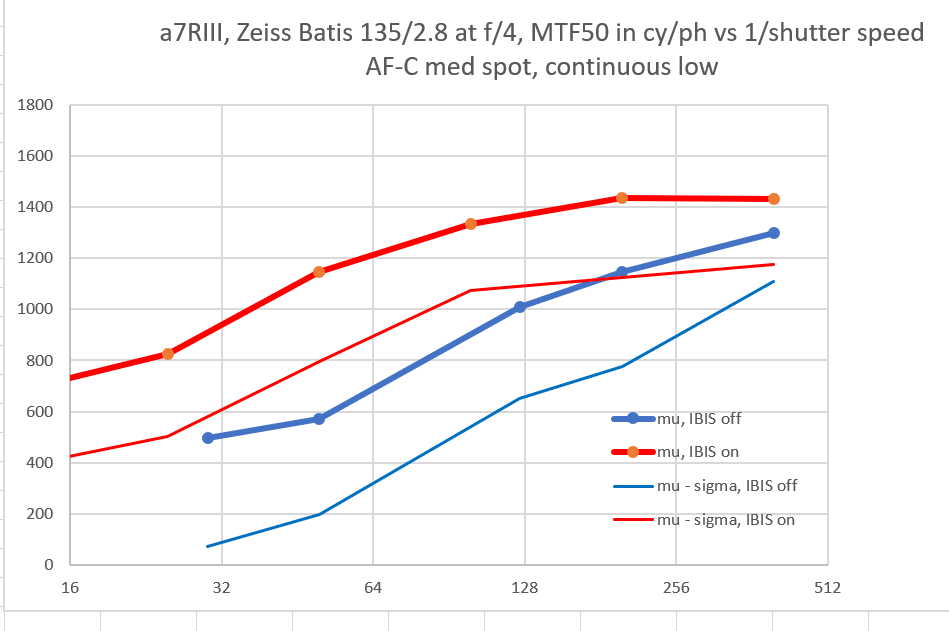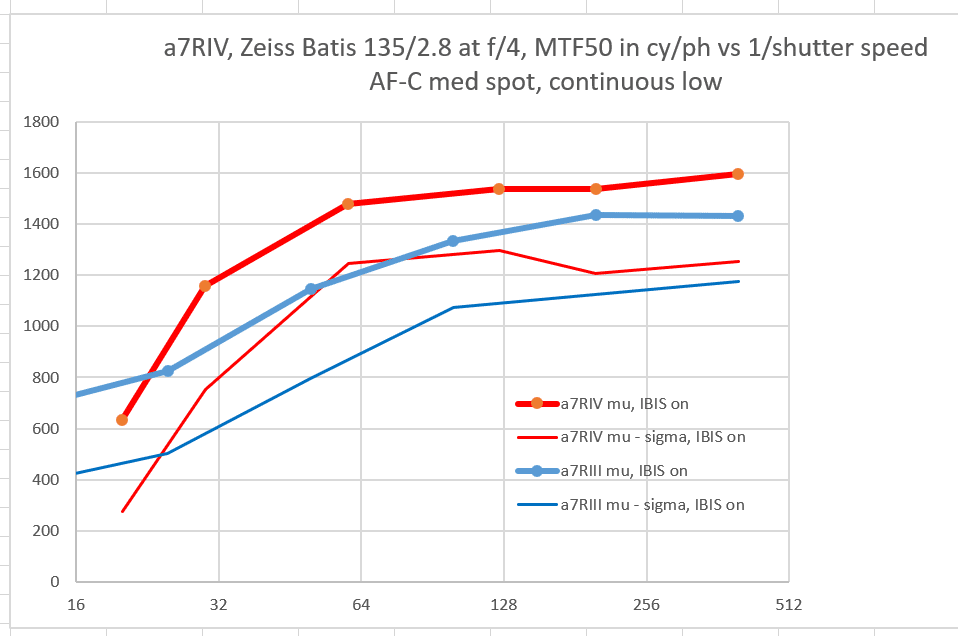This is one in a series of posts on the Sony alpha 7 R Mark IV (aka a7RIV). You should be able to find all the posts about that camera in the Category List on the right sidebar, below the Articles widget. There’s a drop-down menu there that you can use to get to all the posts in this series; just look for “A7RIV”.
Several people have said that the IBIS algorithms on the a7RIV are improved over those of the a7RIII, and have cited some vague Sony marketing materials as their justification for their beliefs. I admit to some skepticism, but was sufficiently intrigued to run a test. I used a Zeiss Batis 135 mm f/2.8 lens on each camera. I set up on this target:
I used the following test conditions
- AF-C, medium spot
- Continuous low drive mode
- EFCS
- Uncompressed Raw
- ISO 100
- f/4
- Exposure mode A
- Aputure 120d II LED, 12-inch parabolic reflector, remotely controlled
With each camera, with IBIS off, I turned the light up all the way, which gave me a shutter speed of 1/400 second. I made 25 continuous-drive exposures, turned the light down about a stop, and did it again. I kept on doing that until the shutter speed seemed silly, then turned IBIS on and ran the series again.
I ended up with about 600 images. I developed them in Lightroom, with default settings except for the following:
- White balance set to flash
- Sharpening turned off
- Noise reduction turned off
I manually adjusted the cropping in Lightroom for each image so that they were centered. This was no fun, but the target that I used doesn’t support auto-alignment. I computed the MTF50 — a nice proxy for sharpness — for all the images with Imatest. Imatest spit out the data in cycles per pixel. I converted that to cycles per picture height to put both cameras on more of an even footing.
I spent an hour or so crunching the data in Excel. Here’s what I got for the a7RIV:
The vertical axis is the MTF 50 in cycles per picture height. The horizontal axis is the denominator of the shutter speed — 1/100 second is plotted as 100. The heavy lines are the mean (aka mu, aka average) values. The thinner lines are the mean minus the standard deviation (aka sigma). At 1/400 second, the results are about the same. But all lower shutter speeds aren’t so hot with IBIS off. 1/200 second with IBIS off is, on average, about the same as 1/30 second with it on. I know some of you are fond of thinking about IBIS improvement in stops; the span from 1/30 to 1/200 is a bit less than 3 stops.
Here are the a7RIII results:
The improvement is somewhat less.
Here are the IBIS-on results for both cameras:
The reason that the a7RIV is sharper at high shutter speeds is that the camera has a smaller pixel aperture due to its finer pixel pitch. It’s go nothing to do with IBIS. But the a7RIV curve is flatter, indicating that the IBIS is working a little better. Not night and day, but not nothing, either. Note that when things go to hell with the a7RIV, they do so more dramatically.
Because the Zeiss Batis 135 has built-in optical stabilization, neither camera is using IBIS for yaw and pitch, but they are using their stabilization algorithms. I may try again with a lens that has no built-in stabilization, but I may not, because I expect roughly the same results, and thanks to the manual alignment required, this test is labor-intensive.




I would read this as the A7R IV providing roughly 2.5 stops of stabilization benefit, and the A7R III providing more like 2 stops. Obviously this is rough, as the exact amount of benefit changes with the focal length.
My worry is that yaw and pitch make a bigger difference than we realise. I could be wrong and perhaps it doesn’t make a huge difference if yaw and pitch are removed from the equation, but I certainly wouldn’t like to bet on it. Nonetheless, those are interesting results so thank you!
I’d be curious to see the plots both normalized to their 1/400 data. I think it might make it easier to spot the differences in the effect of the IBIS.
I just switched from Nikon to Sony so on a steep learning curve and discovered a lot to fill the gaps in your blog, thank you. I shoot sports, so live mostly 1000th and above. On this subject (sort of) – have you done testing at high shutter speed for IBIS and/or OSS?
In hours of reading I have found LOTS of “Bob told me to turn it off over 500th” or “it doesn’t matter”, but little of substance. I see one older test from you at 1/1000th that seemed to indicate no good, no harm, but…
Is there any sharpness downside to leaving it on at higher shutters, e.g. 2000th?
Does mechanical vs. electronic shutter affect the answer?
Are there other downsides, for example, does IBIS introduce any shutter delay? Does it interact with flicker control in any negative way? Impact on battery life?
It’s inconvenient to try to turn it off and on all the time. So the bottom line, is there good reason to believe just leaving it on (handheld, not tripod) is always safe?
Have you heard any official word on this from Sony; I find a dearth of technical info on their site, but maybe have not found it yet.
IBIS does not affect shutter latency. It has little effect on battery life, since the motors are used to hold the sensor in place even when it’s off. I see little reason to use IBIS above 1/1000 second. IBIS and full mechanical shutter sometimes don’t play well together. If you shoot at 1/1000 and above, you probably don’t need IBIS. Caveat: I have not tested this with really long lenses.
Thank you. Why would you assume it does not affect shutter latency, speaking now not of the case where you have used AF-ON or half-push ahead of time (which fires up IBIS), but simply pushing the shutter release, or activating it with a remote. Is there no latency during which IBIS begins to function before it is ready? I am not arguing there is, I am wondering how you know there is not? Also, do you have any more info on your comment on full mechanical shutter and IBIS? When or how do they not play well together? One bad thing is I am finding that Flicker Control will only work with the mechanical shutter, so at field events where I want flicker control I need to turn it on, and at times (e.g. shooting fans at sporting events) I may be at quite low shutter speed.
I’m not assuming anything.
There is, but it doesn[‘t affect the shutter latency, just the IBIS effectiveness.
The IBIS cannot deal with the high frequency vibrations from the mechanical shutter, and sometimes makes matters worse. This is less common as the firmware becomes more sophisticated.